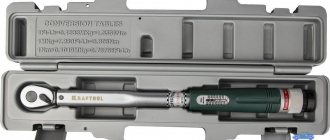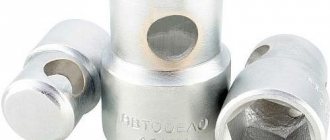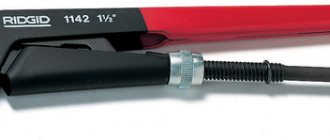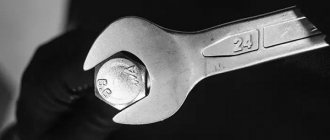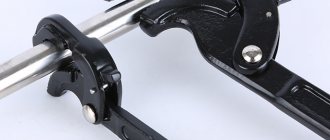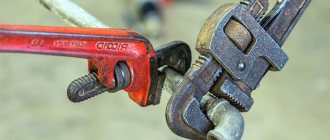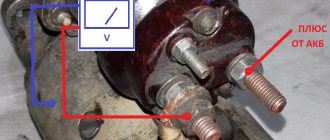Reading time: 6 minutes
Every experienced car enthusiast or professional mechanic knows that many parts in a car require special torque when tightening. So, if a moment is transferred to the nut that is insufficient to fully tighten it, it may become loose when moving, and, on the contrary, by overtightening the fastener, you can cause the part to deform.
That is why a torque wrench is one of the most important components of every specialist’s tool kit. However, it is quite expensive, and some craftsmen make the instrument with their own hands.
Torque wrench
DIY torque wrench
A torque wrench is a tool for service station technicians, designed primarily to ensure uniform application of load on a particular fastener; it ensures uniform tightening of each bolt or nut.
The electronic or pointer scale on this product allows you to tighten parts with an accuracy of tenths and even hundredths of mm.
Upon closer examination, the product is a regular lever with a ratchet at the end, which does not allow the master to overdo it with force and simply scrolls idle, in accordance with the preset parameters on the dynamometer.
A dynamometer is a simple spring mechanism that, when tensioned, causes the needle on the dial to deflect from zero to a user-specified limit value.
At the base of the lever there is a rotating limiter, with the help of which the master sets the exact value of the required maximum force before starting work.
DIY key parts
Thus, having some household appliances on hand, as well as a little ingenuity and knowledge of elementary physics, any man can make something like a key without leaving his home or garage, and the result will not differ much from the readings of a device purchased in a store.
comparison table
The table helps you compare the characteristics of the best torque wrenches.
| Name | Manufacturer country | Type | Peculiarities |
| Gross | Germany | electronic | Built-in adapter, adjustment buttons |
| Alca CR-V 450000 | Germany | auto | Includes case, adjustment elements, durable case |
| Bergr BG-12 TW | Germany | clicky | Versatility, chrome-plated body, small error |
| Heyner 40-200 | China | lever | Adjustable setting ring, reliable design |
| JTC 4933 | Russia | ultimate | Glazed scale, magnifying effect, high precision |
| Hazet 5120-2CT | Germany | electronic | Multifunctionality, advanced technical capabilities, good build quality |
| Kabo Tool ARD 150 | Taiwan | electronic | Durable steel housing |
Torque wrench without scale: how to replace it
In order for the key to be easy to use and to operate normally, the user needs to know a simple formula from a school physics course, namely, that a moment of 10 N*m is the product of a weight of 1 kg applied at a distance of one meter from a point. Thus, it is not difficult to guess that a lever of 0.5 m reaches this value with a force of 2 kg, 0.2 m - 5 kg, etc.
Read also: How to connect headphone wires without a soldering iron
Based on these calculations, the master must purchase or find the following parts for making the tool:
- A handle that has square-shaped tips, and the length of the product must correspond to the above calculations to achieve a more accurate result.
- If you cannot cut the lever, you can always mark it with a marker or simply put on a tight clamp, which will be the starting point for applying the load on the fastener.
- Instead of a dynamometer, you can take an ordinary high-precision steelyard - a scale that shows the load in grams depending on the tension force. Experts advise purchasing this device with a division price of at least 100 grams and a weighing limit of up to 50 kilograms.
Dismemberment.
When turned on, all elements are displayed on the screen
Switching units of measurement is done by simultaneously pressing M
+
P/T
I also haven’t checked the calibration mode, but I suspect that the device will require a stable load of a certain force. I haven’t figured out how to do this yet, so I decided not to check what would happen.
In this regard, it was decided to ask for help from a friend who works in a service center. Such a mechanical sample was found with a force from 42 to 210 Nm
But there are several nuances here:
M
stores the currently configured signal strength into a memory location. There are 50 cells in total.
The keys are equipped with indicator and adjustment mechanisms, both with and without overtightening protection.
These keys have a similar operating principle to the arrow type, but a different appearance. The difference is achieving more accurate results. The tightening torque is fixed by a rotating mechanism with a spiral spring.
Tips from professionals when making a key
The tool may not work the first time, and the measurement will be incorrect. However, any experienced master can give several detailed tips, following which every beginner will achieve the desired result.
If you do not have a lever or materials for it, you can use a regular wrench with an open-end grip on one side and a box grip on the opposite side. However, the ratio of length and torque should be calculated more carefully here, since the size of the arm will most likely be a fractional number.
For better fixation of the steelyard to the lever, you should be especially careful about the place where it is installed. The best option is a carefully drilled through hole, exactly at the point where the load is applied, and the device will never slip off the handle.
Working with a homemade torque wrench
Depending on the required tension, the master may have several steelyards with different weighing limits, each of which must have its own table depending on the load on the arm and torque.
Since all efforts when determining the degree of tightening are applied only to the scales, it is necessary to ensure a comfortable grip on the handle, since 20-30 kg with a poor grip will not allow you to comfortably work with the device.
Read also: Replacing rings Stihl 180 video
Operating principle and device
It is necessary to understand the principle of operation of a torque wrench, because without this you will not be able to properly use the capabilities of this tool.
The device resembles a regular ratchet. But the key difference here is the presence of a special scale. It displays the force that the user applies to the fastener.
The tool is based on a handle that can rotate in two directions. The main scale is applied to the body, and there is an additional one on the handle. The main scale is intended to demonstrate the range of forces relevant to each specific torque wrench.
In reality, it is not difficult to understand how a special torque wrench for a car works. Although they come in different types, the devices are designed approximately the same. The design of a torque wrench depends on its type. Let’s look more specifically at the features of working with pointer, click and electronic devices.
Many motorists who work on their cars independently know what a torque wrench is for. It allows you to apply the required force with maximum precision when tightening threaded connections. That's what a torque wrench is for. This is a device for tightening nuts and bolts with a given and measured force. It is important to know how it is measured. Then it will be easier to understand how to correctly calculate the tightening and pre-set the tool. This force is measured in Newton meters (Nm).
Craftsmen working at service stations can hardly imagine a set of tools for servicing customer cars that does not include a torque wrench. With its help, precise force is measured. These measurements help prevent leaks, depressurization, and breakdown of vehicle components and mechanisms.
The keys have different attachments that are adapted to perform certain tasks. Therefore, it is a universal device with wide functionality. To use one or another attachment, an output square is used. The user mounts a horn-type, union-type or nut-type attachment on it. Don’t forget about screwdriver wrenches, which are useful when working with electronics and very fragile car mechanisms.
The differences between keys of different types are minor. All of them must include in their design:
- handle;
- clamp for setting the torque;
- measuring component or setting scale;
- removable attachment (ratchet);
- socket for nozzles;
- housing with a spring mechanism.
Before purchasing a torque wrench, be sure to consider what specific tasks it will be used for. The main role is played by the size of the fasteners and their location. For hard-to-reach places, it is more convenient to use click and horn devices. And the tool with maximum precision is an electronic type of torque wrench. Although such devices are mainly used in car repair shops, they are not really needed for personal use.
How to measure tightness
To correctly measure the tightening using a homemade device, you need to follow a few simple rules:
- Assemble the device and bring it into working condition - attach the steelyard to the handle, set it to zero, if possible, set the weighing limit with an alarm, and at the end - put the necessary attachment on the working part of the device or initially select an open-end wrench of a suitable size.
- Place the wrench on the nut or bolt. The device will show an accurate value only if the connection with the fastener occurs directly through the lever, and with the participation of one or more adapters and extensions, an error of up to 5-8% is possible when giving the result.
- Carefully pull the steelyard so that its position is strictly perpendicular to the axis of the lever, and the load indicator is not distorted, decomposed into vectors.
- If a normal force has been achieved, the device will confirm this with the measurement result, and the nut will not budge. If the tightening was not sufficient, the fastener will rotate around its axis until the required torque is achieved.
Main mistakes when making a key
Any high-precision tool cannot be manufactured completely without errors, since the master has neither accurate designs nor drawings at hand, and all this can lead to incorrect measurements and subsequent breakdown of car parts. However, many professionals have answers on this matter, offering car enthusiasts a number of recommendations in order to minimize errors and inaccuracies, in particular:
- You should not use soft metal as a lever, which can easily bend when pressed, because the force applied to the steelyard, without maintaining orthogonality, will not give the desired result, and the purpose of the device will be completely lost.
- You should not choose a cheap steelyard, because the accuracy of its measurements is very questionable, and the spring quickly stretches and fails. So, as of December 2022, the cost of scales should be in the region of 400-500.0 rubles. This is not much compared to the price of the torque wrench itself - about 3-4 thousand rubles, and it is better to change the low-quality component immediately.
- When attaching the nozzle to the nut, you need to take into account that it must be perpendicular to the axis of operation of the lever, otherwise the measurement will not work.
- Most steelyards have only an informational function and do not in any way limit the actions of the master, who can easily get distracted and tighten the bolt without paying attention to the scale reading.
Read also: Hadfield steel and knives made from it
Thus, when using a homemade product, the master bears much more responsibility, because the device cannot have the same automatic force reduction functions as a purchased analogue.
Service station
A homemade device is best used to control bolt tension if in doubt. If it is necessary to control the tightening on any complex component part, the car owner should still contact a service station for diagnostics and repairs, and should not replace important components in his garage, because unauthorized intervention can cost much more than the money saved on the key.

